98
®
Personal Computer
Reference Manual
Model No. CF-37 Series
Contents
Key Combinations ..............................................2
LED Indicators .................................................... 3
Touch Pad (Advanced) .......................................4
Touchscreen .......................................................9
Panasonic Hand Writing (Touchscreen) .........11
Display Rotation Tool .......................................12
Standby/Hibernation Functions ......................13
Security Measures............................................16
Computing on The Road ..................................21
Battery Power ...................................................23
Multimedia Pocket ............................................29
CD-ROM/DVD-ROM Drive .................................30
SuperDiskTM Drive .............................................33
PC Cards ...........................................................34
RAM Module......................................................35
Printer ................................................................36
External Display ...............................................37
USB Devices .....................................................41
Infrared Data Communications .......................42
Modem...............................................................44
LAN .................................................................................46
Hard Disk Drive.................................................48
Setup Utility ......................................................49
Smart Boot ........................................................55
Technical Information ......................................56
DMI Viewer ........................................................57
List of Error Codes ...........................................58
Dealing with Problems (Advanced) .................60
Illustrations in this Reference Manual
NOTE:
CAUTION:
WARNING:
[Start]-[Shut Down]: This illustration means to click [Start], then to click [Shut Down].
NOTE provides a useful fact or helpful information.
CAUTION indicates a condition that may result in minor or moderate injury.
WARNING indicates a hazard that may result in moderate or serious injury.
We recommend that this Reference Manual be printed.
Enter :
Fn + F5 :
page:
:
(For some applications, you may need to double-click.)
This illustration means to press the [Enter] key.
This illustration means to press and hold the [Fn] key, then press the [F5] key.
When the cursor is moved to an item under [Contents] or to
shape of the cursor will change to
click is made), the corresponding page in the Reference Manual will be displayed.
This illustration means to refer to the Operating Instructions.
page (green display), the
. Under this condition, if characters are tapped (or a
�
Key Combinations
2
CAUTION
Do not press the following key combinations repeatedly in (quick) succession.
Do not press the following key combinations while using the touch pad (mouse) or other keys.
When a MIDI file is playing, do not use the following key combinations. The tempo of the MIDI file may temporarily slow.
Popup Window
Is displayed when
the brightness is at
its maximum value.
Is displayed when
the brightness is at
its minimum value.
Functions
LCD brightness con-
trol ( down)
LCD brightness con-
trol ( up)
Pressing this key combination adjusts the brightness
of LCD. The brightness setting is stored in memory
separately under the condition the AC adaptor is con-
nected and under the condition the AC adaptor is
not connected.
By pressing this key combination, you can select ei-
ther an external display, LCD or simultaneous, even
if an external display is not connected. Rebooting
the computer, or powering off then on, restores the
display setting of the Setup Utility.
Key
Fn + F1
Fn + F2
Fn + F3
*1
Display change
Fn + F4
Speakers on/off switch
Fn + F5
Fn + F6
*2
*2
Volume control
( down)
Volume control ( up)
Holding down on the keys
changes the sound level.
Fn + F7
*3
Power off using the
standby function
Fn + F8
With Windows 98, this
key combination is not
supported
Pressing this key combination turns off audio from
the internal speakers and headphone jack. Pressing
it again, or rebooting the computer restores the
speaker setting of the Setup Utility.
CAUTION
Disabling the speakers will also disable the warn-
ing beep.
Pressing this key combination adjusts the volume of
the internal speakers and headphone jack.
NOTE
This key combination cannot be used to adjust the vol-
ume of the warning beep and the touchscreen sound.
Pressing this key combination causes the current
screen on the display to be saved to memory, and
powers off the computer. When the computer is pow-
ered on, by sliding the power switch, the saved screen
will be displayed. (The computer must be plugged
into the AC adaptor or have a battery pack with suf-
ficient remaining power installed.)
OFF
ON
Down
Up
Fn + F9
Remaining capacity of
the battery pack
Pressing this key combination displays the remain-
ing battery capacity on the screen.
page 23
A 78
%
B
%
A %
B
%
Remaining
capacity (%)
display
Battery pack is
not installed.
Fn + F10
With Windows 98, this
key combination is not
supported
*1 When the Dual-Display is used, this key combination becomes inoperable.
*2 Under the condition the sound function of Windows is not working,
or
*3 When [Disable] is set for [Fn+F7/Fn+F10 key] with the Setup Utility, these key combinations become inoperable.
is displayed, but the volume does not change.
�
LED Indicators
3
Caps Lock
This indicator lights green when Caps Lock is pressed. Subsequent non-
shifted input is capitalized.
NumLk (Numeric key)
These indicators light green when NumLk is pressed. This causes a por-
tion of the keyboard to function as a numeric keypad. The [Enter] key
functions differently depending on the application.
ScrLk (Scroll lock)
This indicator lights green when ScrLk is pressed. Scroll lock functions
differently depending on the application.
Hard disk status
This indicator lights when the hard disk drive is accessed.
Multimedia pocket
device status
This indicator lights when the multimedia pocket device (CD-ROM drive,
DVD-ROM drive or SuperDisk drive) is accessed.
When the battery pack (including the adaptor) is set in the Multimedia
Pocket, the Multimedia Pocket device status LED shows the same indica-
tions as the battery pack status LED (see below).
Battery pack
status
Not lit :
Orange :
Green :
Red :
AC adaptor not connected or charging not being per-
formed.
Charging in progress.
Charging finished.
Battery is low
(remaining battery capacity is approx. 9% or less).
Battery pack or charging malfunction.
Blinking red :
Blinking orange : Battery capacity being refreshed.
Blinking orange five times after the AC adaptor is connected :
Charging on standby. (The ambient temperature is out-
side the allowable range. Once the allowable range re-
quirement is satisfied, charging begins automatically.)
Power status
Not lit :
Green :
Blinking green : Standby mode
Power off / Hibernation mode
Power on
NOTE
MP is the abbreviation for Multimedia Pocket.
�
Touch Pad (Advanced)
4
Work Surface
Use the touch pad to move the cursor on the display and perform normal computer operations.
NOTE
The touch pad has been designed to work only when a finger is used. Therefore, do
not use any implement on the touch pad.
Basic Operation
Function
Moving the Cursor
Touch Pad Operation
Move the tip of your finger
lightly over the surface.
Right Button
Left Button
Tapping/Clicking
Double-Tapping/
Double-Clicking
Dragging
or
tapping
or
clicking
double-tapping
double-clicking
or
Two quick taps, but on the
second tap leaving your
finger down (applying
pressure) and moving it
on the work surface.
While holding down the
button, moving your fin-
ger on the work surface.
is added for [Drag
When a check mark
Lock] *
After the drag operation (above : left side), it
is necessary to determine the destination (i.e.,
location of drop) by one tap. Under the con-
dition no destination is selected, do not use
the standby or hibernation function. Nothing
is shown on the display, even after resuming
from the standby or hibernation mode.
In this case, the display will return after a tap
or click is made.
* In [Start] - [Settings] - [Control Panel] - [Mouse] - [Tapping]
Scroll*
Scroll a document
(rotate the wheel)
Auto Scroll*
Automatically scroll a document
2
Operate after pressing the two buttons simul-
taneously.
When releasing the auto scroll function:
One tap on the work surface.
(To next page)
�
Touch Pad (Advanced)
5
Touch Pad Operation
Function
Pan*
Scroll in various directions of a
document
Operate while holding down the two buttons.
Zoom*
Magnify/reduce the display of
a document.
Ctrl +
Data Zoom*
Display or hide a document, or
perform operations to return to or
proceed with Internet Explorer.
Shift +
Magnify
Reduce
Keep Scroll
Continue making the screen
scroll by continuously pressing
a corner of the touch pad.
Move your finger up
(down) along the ver-
tical direction on the
right side of the touch
pad, and without lift-
ing your finger, con-
tinue to press down
on the top right (bot-
tom right) corner.
Move your finger to
the left (right) along
the horizontal direc-
tion at the bottom of
the touch pad, and
without lifting your
finger, continue to
press down on the
bottom left (bottom
right) corner.
* Indicates that the movements will differ depending on the application.
(To next page)
�
Touch Pad (Advanced)
CAUTION
6
When an external mouse or trackball with additional functions (e.g., wheel func-
tion) is connected, a part or all of the additional functions may fail to operate. To
use these additional functions, install the driver or application software of the
external device by following the procedure below. However, once the driver or
application software is installed, touch pad functions (e.g., auto scroll) may not
operate even if the touch pad is enabled (see the procedure for “When you want
to re-enable the touch pad.”).
1 Power off your computer (
"Starting Up/Shutting Down") and connect
the external mouse or trackball device to the computer.
2 Turn the power on and run the Setup Utility (
set [Touch Pad] to [Disable] and close the Setup Utility.
page 49). In [Main] menu,
3 Following the operating instructions for the connected external mouse, install
the necessary driver.
When you want to re-enable the touch pad;
1 In [Start] - [Settings] - [Control Panel] - [System] - [Device Manager], when an
external mouse or trackball device is displayed in [Mouse], select [Remove] to
delete it, then select [OK] to confirm the deletion.
2 Power off your computer (
"Starting Up/Shutting Down") and remove
the external mouse or trackball device.
3 Turn the power on and run the Setup Utility (
page 49). In [Main] menu,
set [Touch Pad] to [Enable] and close the Setup Utility.
4 Confirm whether [Alps GlidePoint] exists in [Mouse] (in [Control Panel] - [Sys-
tem] -[Device Manager]).
It is possible that no input is accepted from the touch pad while typing is being
performed. To change the settings, add the check mark for [Tap off when typing]
in [Start] - [Settings] - [Control Panel] - [Mouse] - [Tapping]. (
page 8)
NOTE
The following mouse property items change the values to the factory default values.
Adding a check mark for [No taps during key input] (in [Tapping] - [Typing])
Setting the vertical and horizontal controls of [Scroll domain(s)] (in [Gestures] -
[Settings]) all the way to the left.
Make the above settings when you want the computer to return to the factory default
conditions, after selecting [Default] in [Tapping] - [Settings] and [Gestures] - [Settings].
CAUTION
When [PS/2 Compatible Mouse] is displayed instead of [ALPS GlidePoint] in
[Start] - [Settings] - [Control Panel] - [System] - [Device Manager] - [Mouse]:
1 Select [PS/2 Compatible Mouse], select [Properties].
2 Select [Driver] - [Update Driver], select [Next].
3 Select [No, select drive from list], select [Next].
4 At the [Device Driver Wizard], select [Alps GlidePoint], select [Finish].
5 At the [Insert Disk], select [OK].
6 Input [c:\util\drivers\mouse] and select [OK].
7 Select [Close].
Handling the Touch Pad
Do not place any object on the work surface or press down forcefully with sharp-
pointed objects (i.e. nails), hard objects that can leave marks (i.e. pencils and ball
point pen).
Do not allow contact with substances that could dirty the touch pad, such as oil.
The cursor may not work properly in such cases.
When the touch pad becomes dirty:
Wipe to remove dirty areas by using a dry soft cloth such as a gauze or soft cloth
first applied with detergent diluted with water and then thoroughly wrung.
Do not use benzene or thinner, or disinfectant-type alcohol.
�
Touch Pad (Advanced)
7
Configuring the Touch Pad
When needed, the touch pad can be configured using the following steps.
1
2
Select
[Settings] - [Control Panel]
Select [Buttons]
from the task bar or select [Mouse] from [Start] -
Set the function to be activated when
pressing the left button.
Set the function when double-clicking
either button or the surface of the Touch
Pad.
Set the function to be activated when
pressing the right button.
Set the function to be activated when
pressing the left and right buttons si-
multaneously.
Press this button to return all settings (including the Options settings) of the But-
tons settings display to the factory settings.
NOTE
It is also possible to change the double-click time in [Windows] for [Start] - [Pro-
grams] - [Updd] - [Settings] (
page 10). However, when the double click
time in [Windows] is changed, the double-click speed in [Buttons] is changed. In
addition, the setting in [Buttons] takes effect after the computer is restarted or
enters the standby or hibernation mode.
The scroll function (including the auto scroll function) may not operate depending on the
application. In addition, its response may be slow for rapid repeating actions.
For more information, refer to on-line help.
In the top corners of the Touch Pad, set the
functions to be activated. To change the func-
tions, make selections from within the list boxes.
Easy Launcher can be operated simply by tap-
ping the
mark slowly in the top corner when
the Easy Launcher function is set.
Easy Capture can be operated simply by tap-
mark slowly in the top corner when
ping the
the Easy Capture function is set.
page 8
page 8
When using a browsing function (browsing soft-
ware) such as Explorer or Internet Explorer, you
can also use the operation surface of the touch
pad to perform the operations of [Back] / [For-
ward].
When sliding your finger from the center of the
operation surface to the left: Back
When sliding your finger from the center of the
operation surface to the right: Forward
(To next page)
3
Select [Gestures]
Set whether to enable or disable
the scroll function. When the
scroll function is used, scrolling
operations are possible even
when the pointer is not moved to
the scroll bar. In addition, it is
possible to perform the opera-
tions of zoom and data zoom.
�
Touch Pad (Advanced)
8
NOTE
When Easy Launcher is operated, the window displayed
on the right is shown. With Easy Launcher, it is possible
to start an application, shut Windows down, or operate
a window. Some applications may be unable to be
closed or minimized. In such cases, try pressing the
Exit button or the Minimize button in the application.
When Easy Capture is operated, the window display on
the right is shown. With Easy Capture, it is possible to
paste an image or characters to the currently running ap-
plications with the Touch Pad.
4 Select [Settings]
Set the scroll speed for when the scroll function is
enabled.
Set the area for scroll operations on the Touch Pad
and the area of operation of each
mark (in each
corner).
The regions where the scrolling areas in the hori-
zontal and vertical directions overlap become the
operating areas of the
marks.
Make necessary changes, click [OK].
Adjust the tapping speed on the work surface.
5
Select [Tapping]
If the box is checked, it is possible to make a drag
lock setting whereby the drag condition is main-
tained after dragging via a tap operation even if the
hand leaves the work surface. In addition, it is pos-
sible to select the method of release from the drag
condition, i.e., [Auto Release] or [Tap Release].
When [Auto Release] is selected, it is possible to
set the time for release.
When the box is checked, there is no response when the Touch Pad is tapped while
typing is being performed. It is possible to adjust the time to return to the tap function
enabled condition after the typing has stopped, i.e., from [Short] to [Long], with [De-
lay after last key is hit].
CAUTION
When [Tap Release] is set, do not enter the standby or hibernation mode during
drag lock. After resuming, nothing will be shown on the display.
In such cases, tap the work surface or click a button.
Make necessary changes
Select [OK]
6
7
�
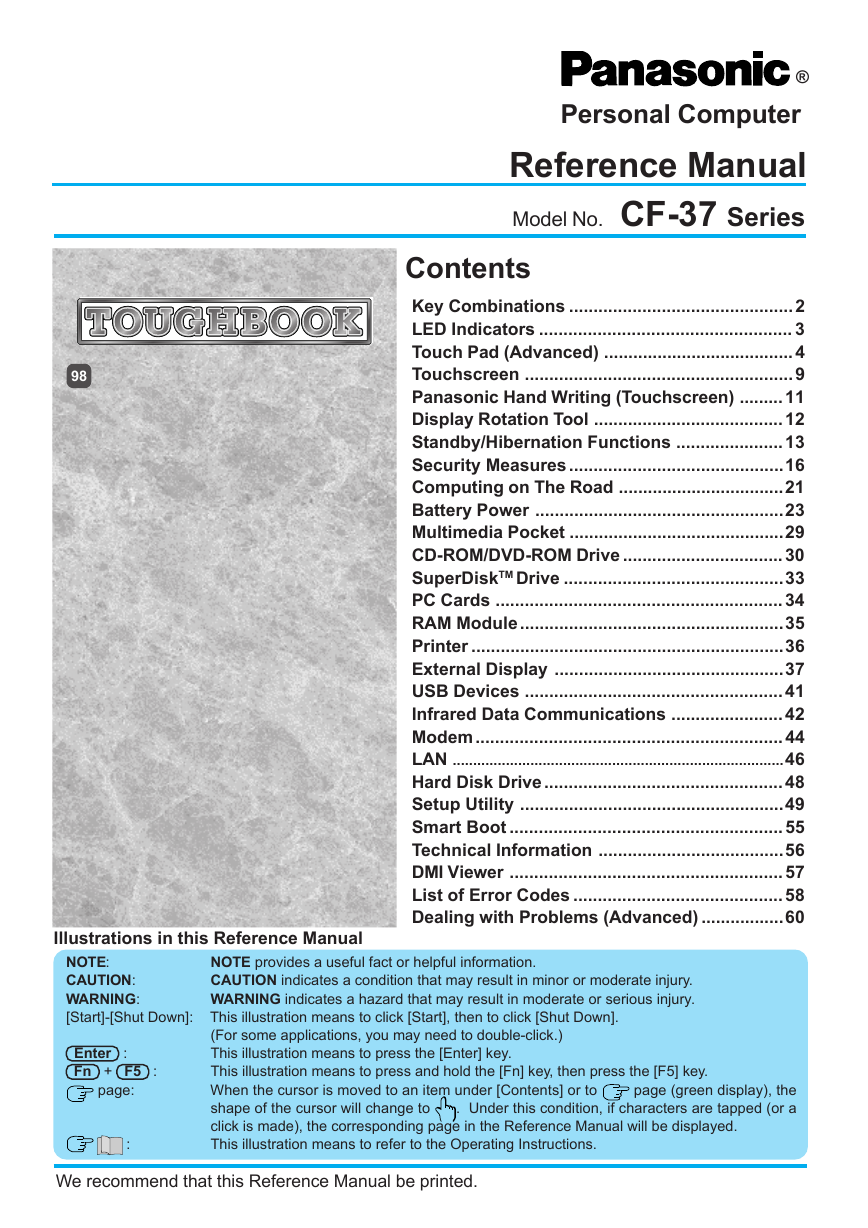
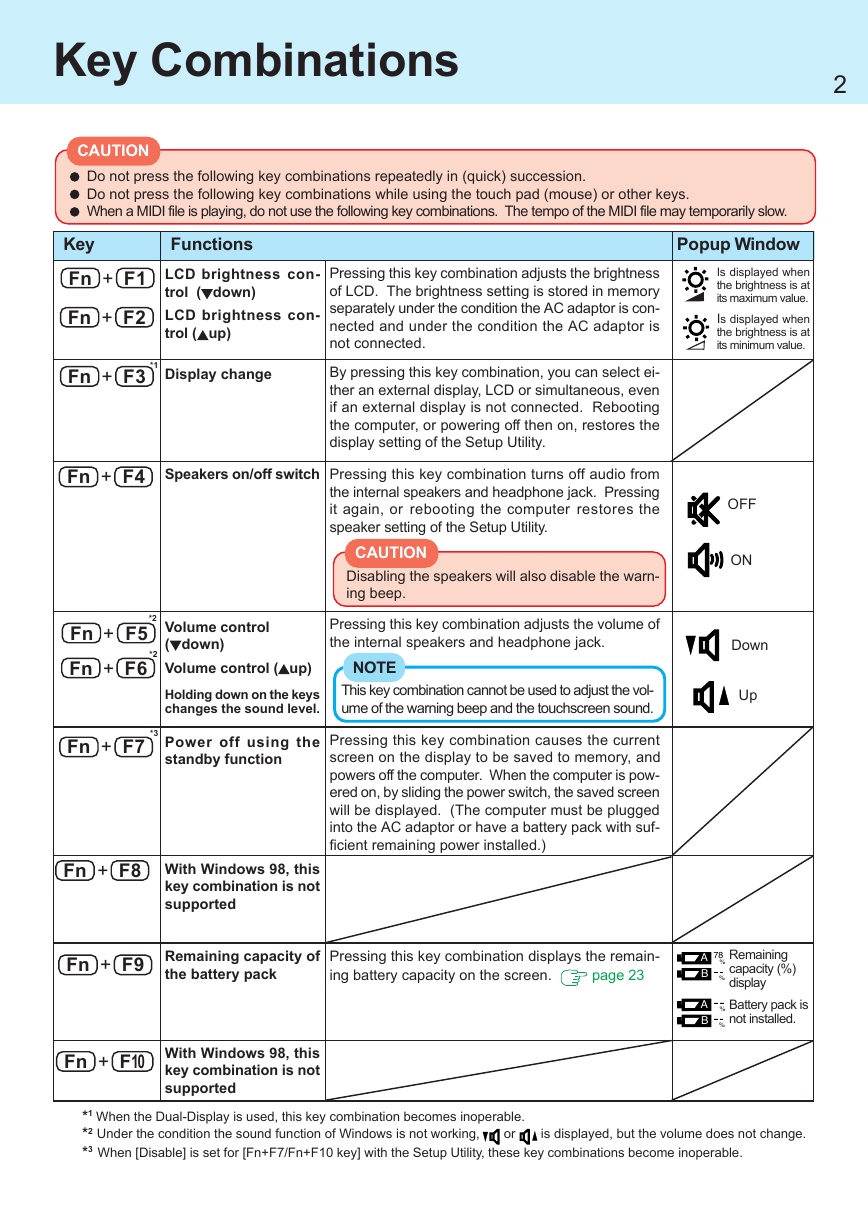
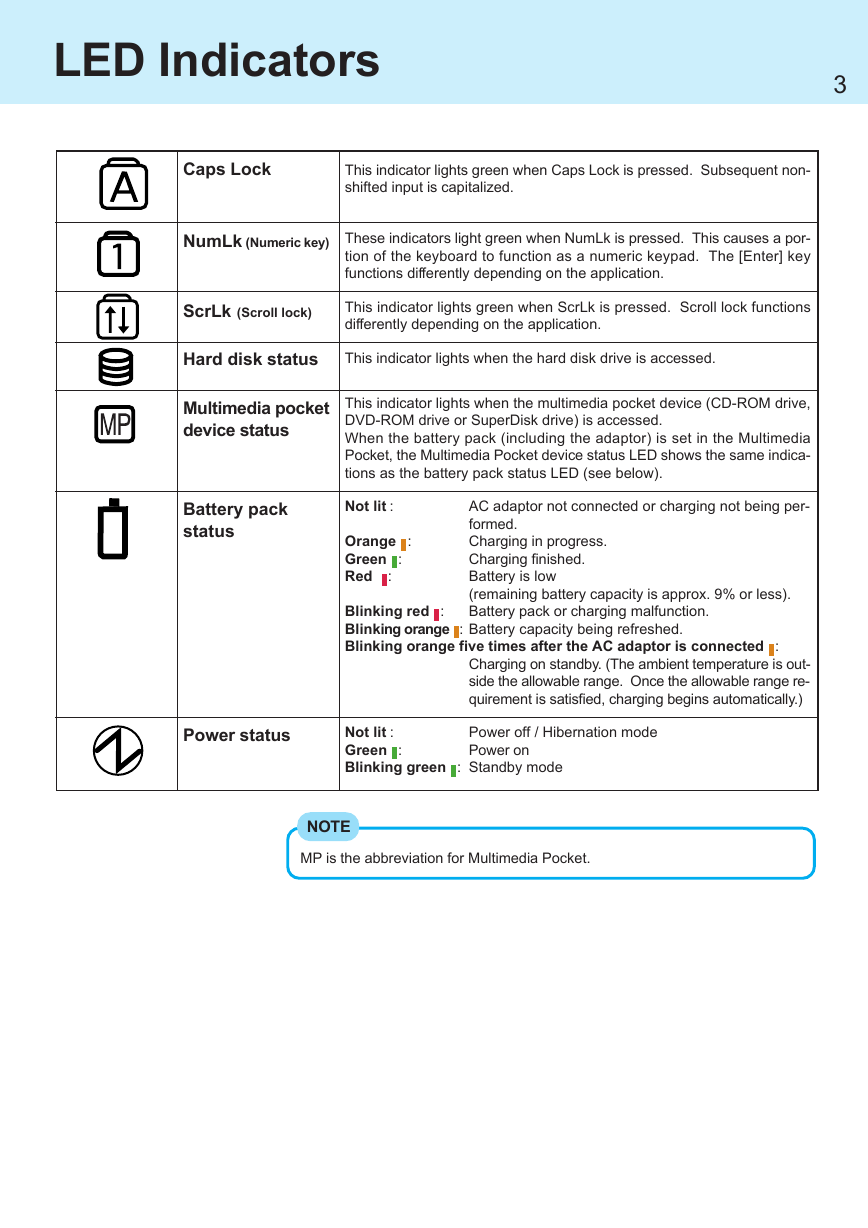
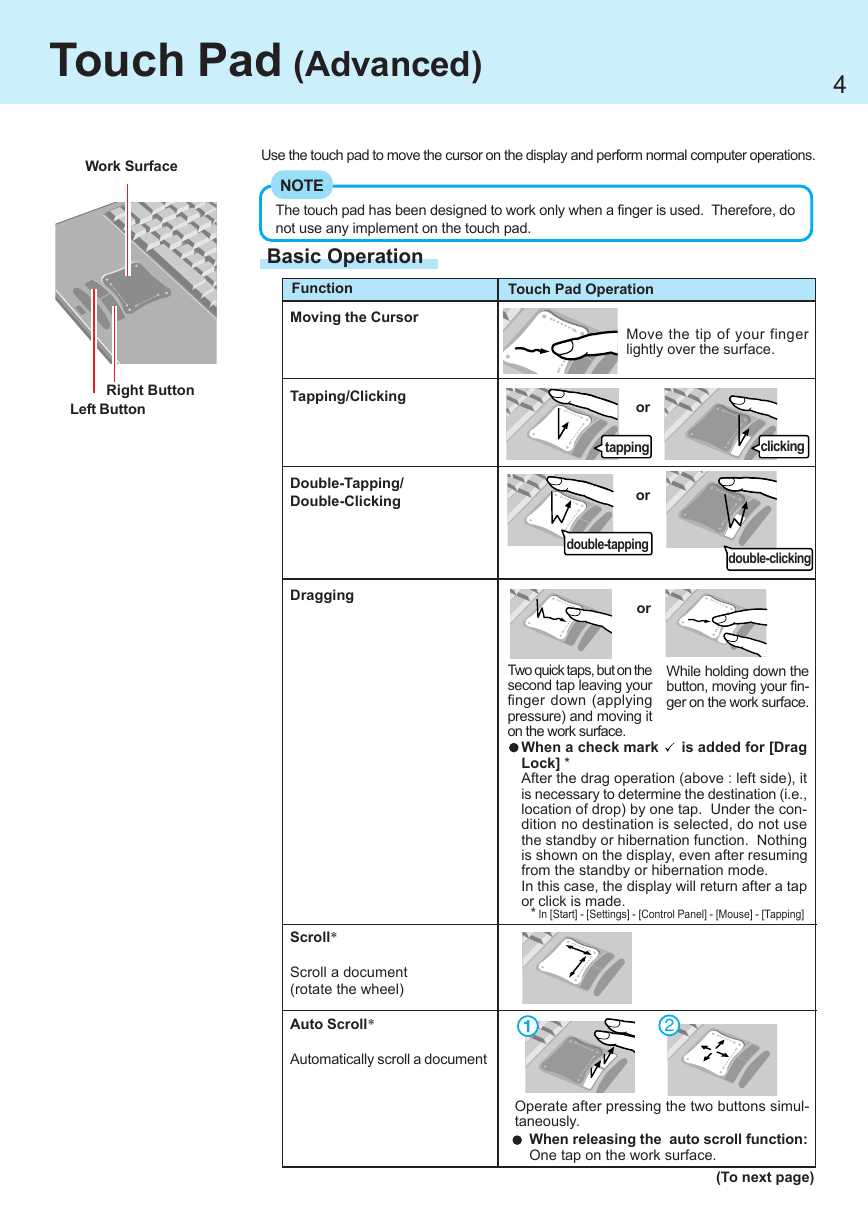
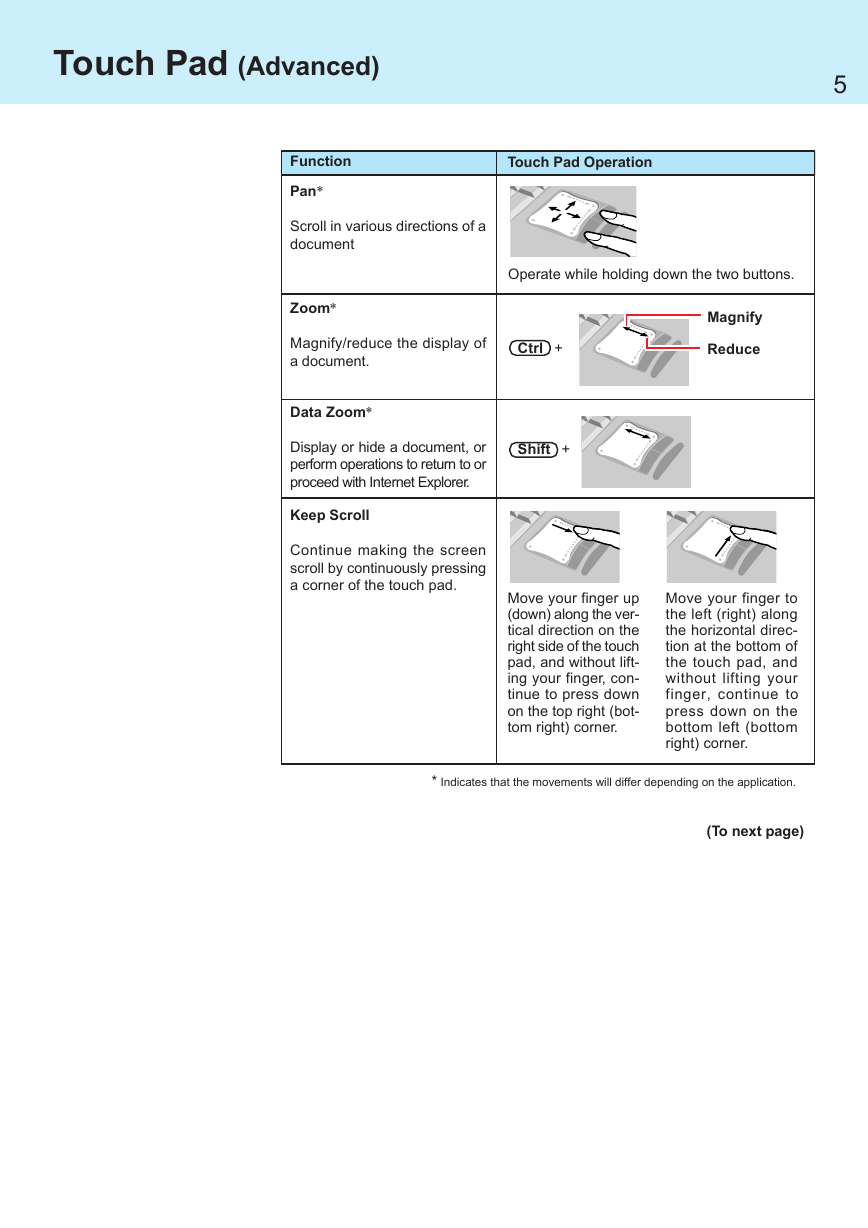
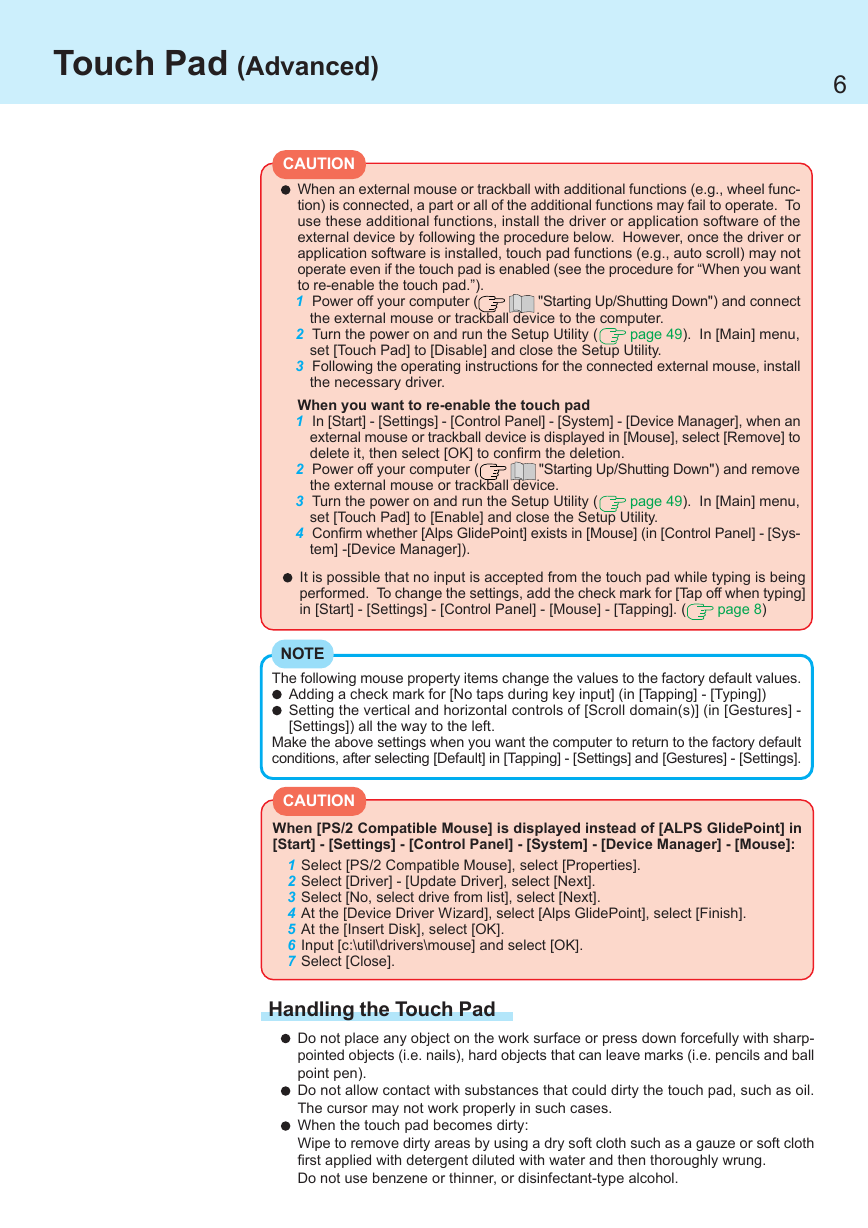
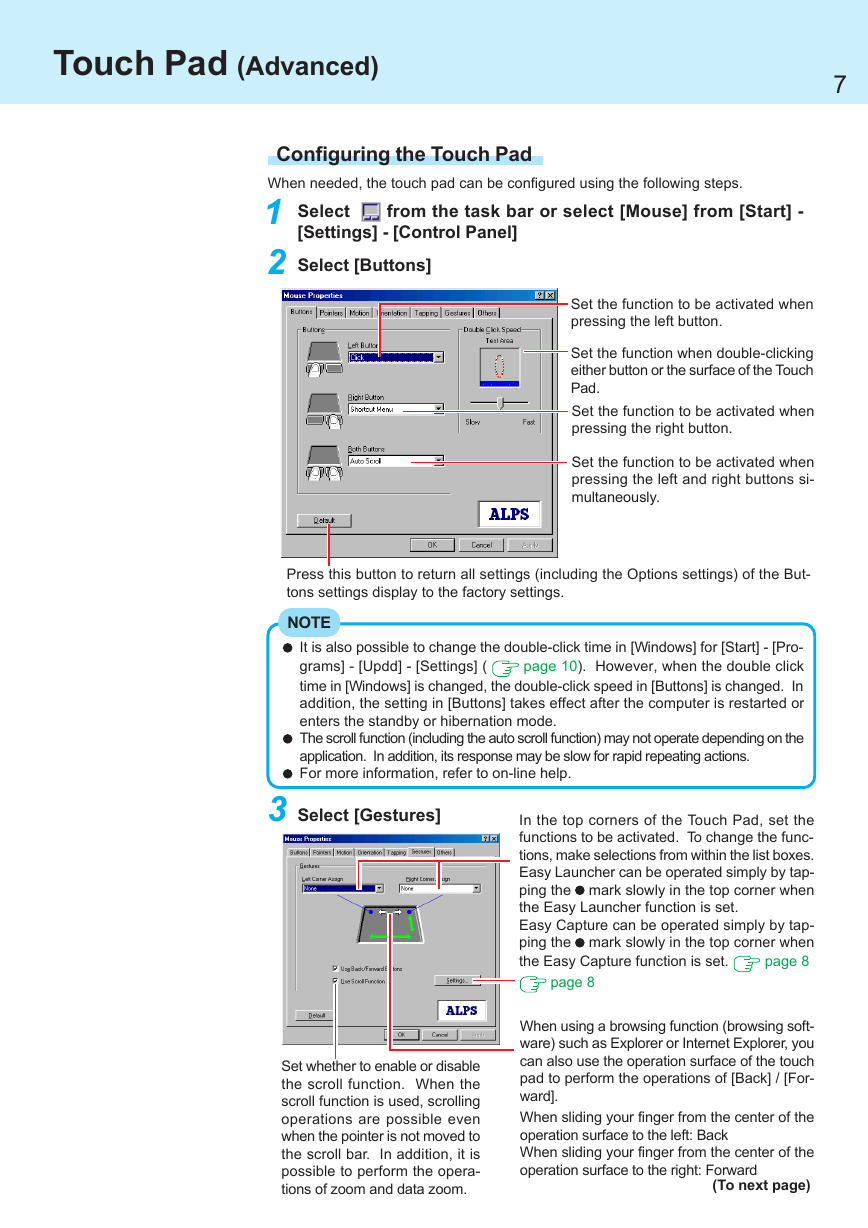
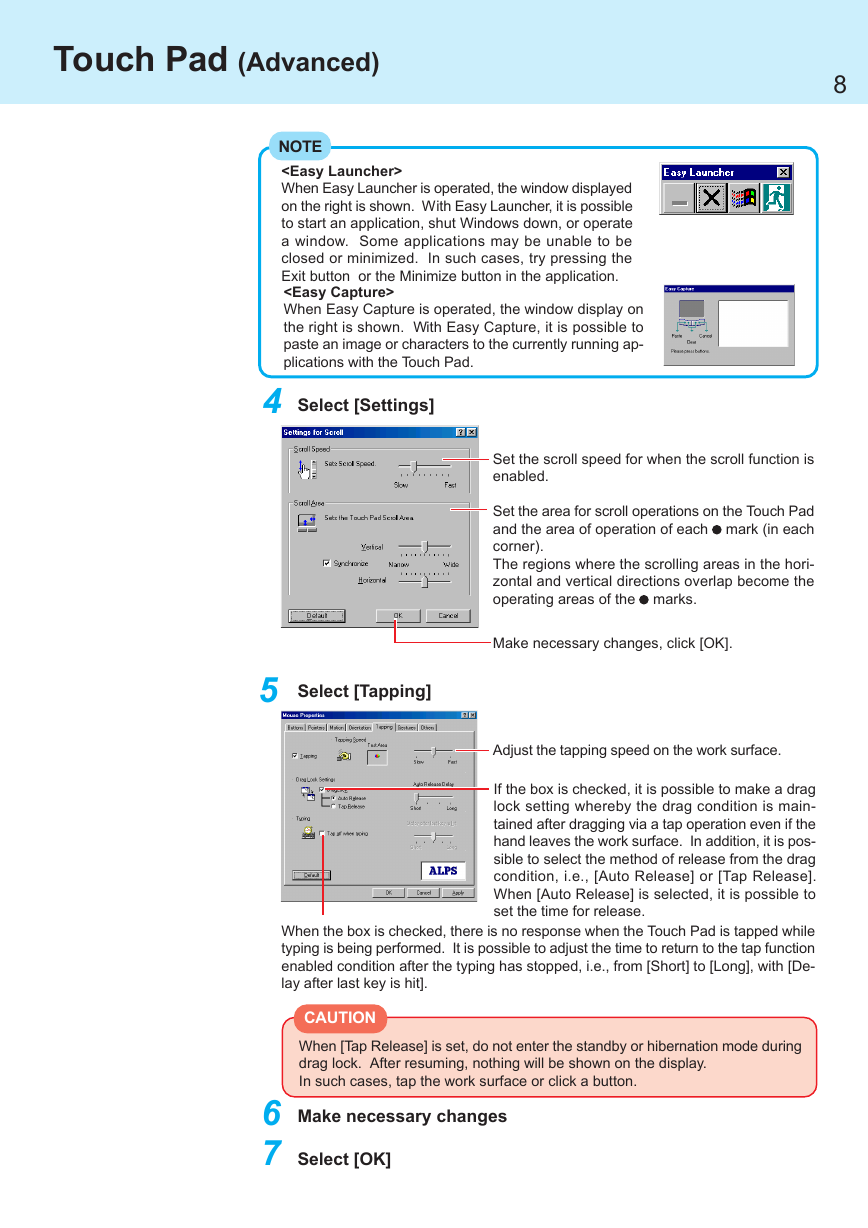








 2023年江西萍乡中考道德与法治真题及答案.doc
2023年江西萍乡中考道德与法治真题及答案.doc 2012年重庆南川中考生物真题及答案.doc
2012年重庆南川中考生物真题及答案.doc 2013年江西师范大学地理学综合及文艺理论基础考研真题.doc
2013年江西师范大学地理学综合及文艺理论基础考研真题.doc 2020年四川甘孜小升初语文真题及答案I卷.doc
2020年四川甘孜小升初语文真题及答案I卷.doc 2020年注册岩土工程师专业基础考试真题及答案.doc
2020年注册岩土工程师专业基础考试真题及答案.doc 2023-2024学年福建省厦门市九年级上学期数学月考试题及答案.doc
2023-2024学年福建省厦门市九年级上学期数学月考试题及答案.doc 2021-2022学年辽宁省沈阳市大东区九年级上学期语文期末试题及答案.doc
2021-2022学年辽宁省沈阳市大东区九年级上学期语文期末试题及答案.doc 2022-2023学年北京东城区初三第一学期物理期末试卷及答案.doc
2022-2023学年北京东城区初三第一学期物理期末试卷及答案.doc 2018上半年江西教师资格初中地理学科知识与教学能力真题及答案.doc
2018上半年江西教师资格初中地理学科知识与教学能力真题及答案.doc 2012年河北国家公务员申论考试真题及答案-省级.doc
2012年河北国家公务员申论考试真题及答案-省级.doc 2020-2021学年江苏省扬州市江都区邵樊片九年级上学期数学第一次质量检测试题及答案.doc
2020-2021学年江苏省扬州市江都区邵樊片九年级上学期数学第一次质量检测试题及答案.doc 2022下半年黑龙江教师资格证中学综合素质真题及答案.doc
2022下半年黑龙江教师资格证中学综合素质真题及答案.doc